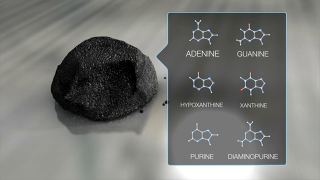Does DNA Have Extraterrestrial Origins?
If terms like adenine and guanine bring back unpleasant memories of Genetics 101 here's one reason to give the words a second thought: A team of scientists has discovered that these and other DNA building blocks can form in outer space and have been deposited on Earth's surface by meteorites. To reach this eye-opening conclusion, researchers ground up and analyzed a set of twelve meteorites collected from Antarctica and Australia. Within them, the scientists found a treasure trove of molecules that may have played a key role in allowing early forms of life to form. Adenine, which helps make up the rungs of DNA's spiraling, ladder-like structure, turned up in eleven of the meteorites. Guanine, another key building block of DNA, was present in eight. Two of the twelve meteorites also contained something extraordinary—exotic molecules that are so rare on Earth that they prove the DNA building blocks must have formed in outer space. The discovery lends support to the theory that a kit of pre-made parts from meteorites or a comet might have kick-started life on Earth. Learn more about the breakthrough in the video below.

Meteorites recovered in Antarctica and Australia lead scientists to believe DNA building blocks exist in space.
See how NASA's Michael Callahan led a team that found molecules on meteorites that form the basis of DNA.

A rover hunts for meteorites at Elephant Moraine in Antarctica, the source of one of the 12 meteorites the team studied.

Back in the lab the scientists pulverized the carbon-rich rocks and poured them into vials for analysis with a spectrometer.

The payoff: They detected bits of the building blocks of DNA, such as adenine and guanine, that suggest such molecules can form in space.
For More Information
See NASA.gov
Credits
Please give credit for this item to:
NASA's Goddard Space Flight Center
Rover photo courtesy of NASA/GSFC/Michael Callahan
Other images courtesy of Carnegie Melon University's Robotics Institute
-
Animators
- Chris Smith (HTSI)
- Tyler Chase (UMBC)
-
Video editor
- Chris Smith (HTSI)
-
Interviewee
- Michael P. Callahan (NASA/GSFC)
-
Producer
- Chris Smith (HTSI)
-
Scientist
- Michael P. Callahan (NASA/GSFC)
-
Videographer
- Ryan Fitzgibbons (USRA)
-
Writer
- Adam P Voiland (Wyle Information Systems)
Release date
This page was originally published on Thursday, September 15, 2011.
This page was last updated on Wednesday, May 3, 2023 at 1:53 PM EDT.
